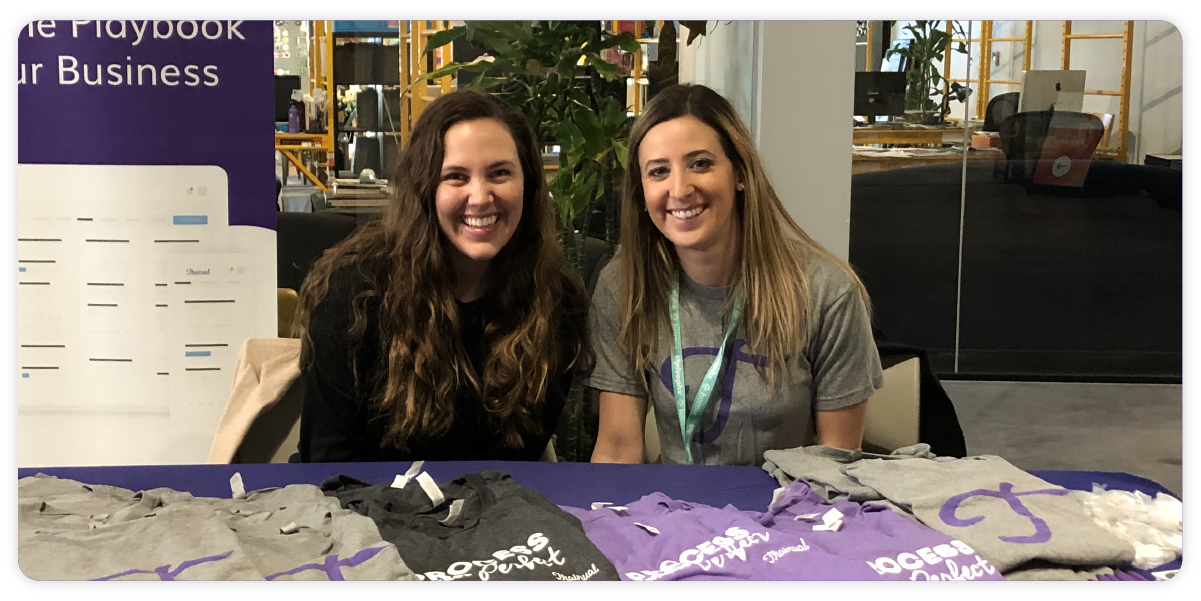
Articles
Employee Development: 5 Easy Ways To Level Up Your Team
April 15, 2021

This might seem obvious - but turnover gets in the way of growth. That's because your employees make what your business does happen. And if you're constantly retraining new people, you're not getting as much done.
But to get people to stick around long enough to see this growth, you need them to be growing too. That's where employee development comes in. AKA an actionable game plan for how you'll support your business goals while fostering your employees' skills!
And before you ask, yes, this really works! According to LinkedIn, 94% of employees say they stay with a company longer if that employer invests in their career.
And when compared across generations, Millennials care more about employee development than Boomers or Gen Xers. Meaning, now - more than ever - business leaders need to start investing in employee development. So, here's where you can start:
What is employee development?
Employee development is a joint initiative (between you and your employees) to level up your employees' skills and responsibilities. Meaning, it's how you strategically nurture your team members' personal and professional growth.
So, your employee development plans should consider both your company's and your employee's goals. That way, you can deliver real business results while ensuring your employees continue to feel fulfilled in their roles.
Plus, when done right, employee development improves company morale. Because it sets the stage for meaningful professional growth. And it provides employees the tools to be the best at what they do. So, they feel confident in their abilities and valued by you! Which tends to produce better results.
In fact, studies show that employee development can actually improve employee engagement (including satisfaction, productivity, and performance). And as a result, boost business performance by 202%. So, whatever you invest into employee development, you more than double on return!
🔥 Tip: Trainual makes it easy to deliver employee development content to your whole team. That way, everyone in your company gets on track to hit their personal and professional goals - and your business collectively levels up. Try for free.
The difference between training and development
Both employee training and development aim to improve and broaden an employee's skills over time. And they both focus on a mix of technical skills (like analyzing metrics and managing client relationships) and soft skills (like leadership, communication, and collaboration).
But employee training focuses on the skills and knowledge an employee needs to succeed at their current job. While employee development focuses on the skills and knowledge they'll need to score their next opportunity (typically, through a promotion).
Because of that, training and development often work hand in hand. Training makes sure your employees are currently successful at your company. And development ensures that they'll continue to be successful at your company - while moving up in the process.
Why does employee development matter?
Running a full-blown employee development program may seem like a lot (especially if you're in the early stages of business). But by investing in your employees today, you're really investing in your business’ success tomorrow.
Here's what I mean:

1. Close the skills gap
In an increasingly automated world, some skills are becoming irrelevant. Between 2018 and 2028, Deloitte estimates that 2.4M positions will go unfilled in manufacturing alone.
That's because as jobs are automated, other jobs overseeing that automation pop up. And the people who filled the old roles don't have the skills to fill the new ones.
But by having an employee development program, your team stays ahead of the curve. Because instead of just focusing on the technical skills that might become outdated, you focus on soft skills too. AKA skills like leadership and collaboration that robots can't do and will always be necessary.
That way, your business doesn't leave people behind as it evolves. And your existing team can easily adapt to whatever your business needs next.
2. Close the talent gap
The talent market is tightening thanks to a flood of retirees - and there's more on the horizon. According to SHRM, the majority of the workforce will be 40 years or older by 2026. And the number of people retiring will outpace those entering the workforce.
This leaves a talent gap between who has the skills now (Boomers and Gen Xers) and who will need them in the future (Millenials and younger). And unless you're developing your younger employees, your older employees will retire - taking the skills you need with them.
But by involving both groups in an employee development program, you can fill this gap. That's because your tenured employees can teach your newer employees the skills to take over higher-level roles - before they retire.
3. Close the virtual gap
With the pandemic, a lot of employees are now working from home. And while it's proven great for productivity, it comes at the expense of collaboration and learning opportunities.
That's because everyday conversations, industry events, and conferences aren't taking place. So, employees aren't gaining the skills and knowledge that they used to just stumble upon. And the result is a virtual gap, where remote employees are developing slower than in-person ones.
But rather than bringing everyone back into the office and sacrificing productivity, you can create a remote employee development plan to fill the gap.
For example, you can foster mentorships between managers and frontline employees using Zoom. Run your own company-led conferences online. Or, invest in Trainual as a virtual leadership tool to offer training and development anytime, anywhere.
👉 Get started on building your own virtual leadership tool in minutes with Trainual. Try for free.
How to make an employee development plan
Making your own employee development plan comes down to 4 easy steps: define what you're developing, personalize it to the employee, offer the right opportunities, and track the results.

Step 1: Define what you’re developing
Start by asking yourself: how will my employee development plan support the company's goals? The answer could be to fit a skills gap, attract new talent, or reduce turnover. Really, it depends on your unique goals!
If you're not sure, start by looking at where your business is now. And compare it to where you want to be.
Then, clearly define how you'll get there with your current team. AKA what skills will your team need to get there. Take note of what challenges and opportunities might arise along the way.
For example, maybe a large portion of your workforce is set to retire. Meaning, you'll need to figure out how to transfer knowledge and fill those roles sooner than later.
So, you use your employee development plan as an incentive to attract young talent. And have your tenured employees share what they've learned throughout their careers. That way, when your first retiree walks out the door, there will be someone on standby, ready to take over.
Step 2: Personalize it to the employee
Employee development isn't one-size-fits-all. Instead, it's fitted to the employee. So, you need to ask your employees individually how they want to grow in their careers. Quarterly reviews or 1:1s are great opportunities to host this conversation.
Then, use their answer to inform their employee development plan. For example, if someone wants to become a people leader, provide them opportunities and resources to learn the necessary leadership skills. Such as owning a project that has more responsibility or a mentorship program.
Just be sure to consider their unique learning style as well. Here at Trainual, we explicitly ask each team member how they learn best. That way, we can tailor the employee development plan to them (and make it more successful).
Step 3: Offer the right opportunities
The perfect development plan relies on a combo pack of opportunities, with each one contributing to the company's and employee's goals.
Take your Social Media Coordinator. They might want to get promoted, and you might want more engagement online. So, you offer cross-training opportunities, weekly coaching sessions and pay for them to attend a few industry events. That way, the Coordinator is learning new strategies and skills to help meet both parties' goals.

When you provide multiple opportunities, employees might only take you up on a few of them. That's okay! Employee development opportunities should be 100% optional. Because if someone doesn't want to level up (or an opportunity isn't right for them), then that's their choice! The important thing is that the opportunities (note the plural) are available.
But to encourage more people to take advantage of your employee development program, you can also have your employees present the opportunities they're interested in.
If you go this route, make sure they explain how the opportunity will further their career and what they expect to gain. And have their direct manager approve the opportunity (based on company goals) and keep employees accountable along the way.
🔥 Tip: At Trainual, we have employees bring the opportunities that they're excited about. And if they're not available, we'll literally host it ourselves (that's how we ended up hosting Training with Empathy and Playbook 2020).
Step 4: Track the results
Only 8% of companies measure the impact of their employee development programs. And it often ends up being a costly mistake. The average SMB spends around $1,000 per employee for training and development each year.
If a development opportunity doesn't contribute to the company or employee goals, there's no point reinvesting in it. But most companies do because they don't know it's ineffective. So, you'll want to measure each employee development opportunity's impact on the individual and organizational levels.
Measure the individual impact
On an individual level, have managers periodically check in to measure employees' progress. This might mean testing their new skills or just talking through if they got what they wanted from the development experience.
You can even have employees document what they learned. This way, they retain it better, and the rest of the team can learn from their experience.
Measure the organizational impact
On an organizational level, calculate the return on investment (ROI) by tracking what you spent on development and figuring out the monetary benefits.
The costs of your employee development program are easy to track. But the monetary benefits are a bit trickier.
Development doesn't produce any obvious profits, so you'll need to look at metrics that reflect your company's goals. For example, cost savings or indirect impacts on the company's income. And to do that, you might need to assign a value to certain data points (like employee retention).
Then, calculate the ROI with this formula:

5 easy ways to develop employees
There are a ton of options when it comes to employee development. And there's no wrong place to start.
You can start small with consistent coaching. Or, you can go all out by providing time off and reimbursements for development events. It really just depends on where your company's at - and what you want to get out of your program.

So, here's a few highly effective employee development ideas to get you started:
1. Consistent coaching
Providing consistent coaching is one of the easiest ways to develop employees. And often, it gets overlooked next to more extensive methods. But there's little preparation to start coaching, and the initial investment is minimal (besides the time spent in weekly meetings).
Plus, with consistent check-ins on professional and personal goals, your managers can keep employees accountable. And ultimately, use the time together to set team members and your company up for success.
Schedule roughly 45-minutes weekly for employees to meet with their direct managers. That way, they can really dive into what's going on (personally and professionally) in the employee's life.
This time can be used to review projects, remove obstacles, or provide real-time feedback. That way, your employee is continually leveling up their skills - while feeling supported in their role.
🔥 Tip: Need a fill-in-the-blank framework on how to provide feedback to your team? Use our free employee performance review template.
2. Cross-train employees
Cross-training is the process of training your employees on tasks that lie outside their job description.
This can mean training people across roles or across departments. For instance, teaching your customer service team how billing works. That way, if a problem arises, they can take care of it quickly - instead of waiting for finance's help.
By cross-training your employees, you provide new skills and help them understand how the business comes together. And it allows for anyone to pick up any extra slack (even if it's "not their job"). So, if someone is out sick or quits unexpectedly, your business doesn't skip a beat.
But cross-training doesn't have to be a whole thing. When someone asks a question about another role or department, simply share the Trainual subject that covers it with them. That way, they're learning the answer, getting context on how their role relates to others, and filling their personal interests.
3. Hold 90-day challenges
During a 90-day challenge, employees set a goal and have 3 months to accomplish it. And you can run this as both an inside and outside of work development opportunity.
Meaning, have employees set their personal goals. This should be something that has nothing to do with work that they really care about. For example, reading a certain number of books, practicing yoga every day, or training for a marathon.

Have your team submit these goals so you can connect them with team members with similar goals. This way, they can hold each other accountable throughout the 3 months.
Meanwhile, have your employees work with managers to set their professional goals. These could include reaching a sales goal, finishing a project, or learning a new skill. Just make sure these goals reflect your company's goals as well as the individual's.
Then, set up routine check-ins to keep employees accountable. If you already host weekly coaching sessions, feel free to add 90-day challenge check-ins to the discussion topics.
And when a team member accomplishes a 90-day challenge (personal or professional), be sure to recognize them in style! Announce the win at your next all-hands meeting, or reward the employee with a small cash bonus. Either way, give them a reason to keep crushing their goals!
4. Development fund
If you want to take a more extensive approach, consider starting a development fund for your employees. A development fund provides company-paid development opportunities and time off (without using up PTO) to complete them. And it can be up to the company or employee to find these opportunities.
🔥 Tip: Write out exactly how your employee development fund works, and store it in Trainual. That way, no one is left guessing on how they can or can't use it. Try for free.
If your company wants to present the opportunities, consider sending out a monthly roundup to all your employees. Invite your team to sign up for what interests them, and then work with management to find a good time to complete the programs.

If you want to leave it up to your employees, be sure you have a process in place for requesting development opportunities. For example, have team members do the research first (including cost and anticipated ROI). Then, have managers approve or provide feedback based on what employees suggest.
5. Leadership training
Leadership training is something that should make it onto everyone's employee development plan. Because what it really teaches is how to effectively communicate and collaborate.
Admittedly, leadership training is a pretty wide-net term. So, if you're just kicking off your employee development program, start by focusing on what role empathy, diversity, and biases have in the workplace.
You can either build your own leadership training into your existing training - if you have the knowledge in-house. Or, you can invest in a 3rd-party organization to lead your training (like Collective).
At the end of the day, the employee development opportunities you use are totally up to you. But you need to be offering something. That way, you can make sure your employees (and your business) are constantly leveling up - and ultimately, sticking around.
Similar Blog Posts












